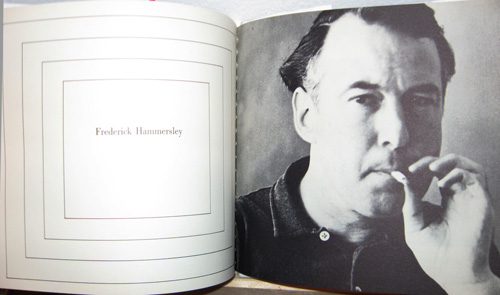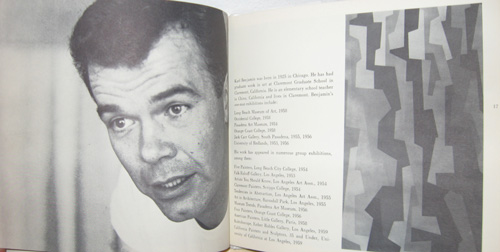I’m a very big fan of the interlibrary loan system. It’s an ultra-convenient, yet easily overlooked way to check out (in both senses) rare, out-of-print art books.
One such book I checked out recently is Four Abstract Classicists, the exhibition catalog for a show including Karl Benjamin, Lorser Feitelson, Frederick Hammersley, and John McLaughlin at the Los Angeles County Museum of Art in summer/fall 1959.
While I think of these artists as giants of modern painting, this slender, mostly black-and-white volume brings them back to human size. Four Abstract Classicists also offers itself as a time capsule of coolness, from a time when art was moving away from abstract expressionism to the clean, efficient aesthetic of 1960s hard-edge painting. It was a revolutionary time in art, albeit a quiet revolution, in my opinion.
In his introductory essay, Jules Langsner contrasts classical art and abstract art according to their respective artmaking processes. “When it comes to art, the classicist seeks ordered relationships of a kind seldom found in the helter-skelter of raw existence,” Mr. Langsner writes. “To achieve impeccable order the classical artist consciously edits ideas rising to the surface from the unconscious. A classical work is deliberated rather than produced spontaneously.”
Abstract Classicists produce work differently, Mr. Langsner observes. “An Abstract Classicist painting may develop step by step, one form suggesting another, or the ‘idea’ for the picture may precede its placement on canvas.”
And from there, Mr. Langsner quotes Frederick Hammersley, who describes his creative process as follows:
“I compose a painting by hunch. A ‘hunch’ painting begins by having several different sizes of canvas around. By seeing them every day I will for some unclear reason pick up one. Part of the time I have no idea to begin with. I like the size and shape in front of me and I try to put marks on it to go with it. It seems to be a process of responding or reacting to a particular ‘liked’ canvas.
“At first I would paint a shape that I would see there. That one colored shape in that canvas would work, or fit. The next shape would come from the feeling of the first plus the canvas. This process would continue until the last shape completed the picture.

Frederick Hammersley, one of the “four abstract classicists”
“The structure making is of prime importance,” Hammersley continues. “Until this is right nothing further can be done. After the picture works in line the shapes become colors. I answer the hunch as it comes.”
I enjoy hearing artists talk about their art-making process, because everyone is different, it seems, and there’s something to be learned from each story. Reading Mr. Hammersley’s quote, I realized just how divorced my own initial hunches (ideas) can be from the actual canvas. And perhaps I could gain something from focusing on the canvas first. I don’t really paint free-form anymore; I’ve done so only occasionally before.
“Abstract Classicist painting is hard-edged painting,” Mr. Langsner continues. “Forms are finite, flat, rimmed by a hard, clean edge. These forms are not intended to evoke in the spectator any recollections of specific shapes he may have encountered in some other connection. They are autonomous shapes, sufficient unto themselves as shapes.”

Karl Benjamin, pictured as an abstract classicist
This is an art that exists for itself. No representational tie with reality, but instead a window, perhaps into another reality, which in itself is completely unreal. And that’s what I love about it. This style of painting is classic — timeless — for that reason, even though the term “abstract classicism” didn’t really stick.